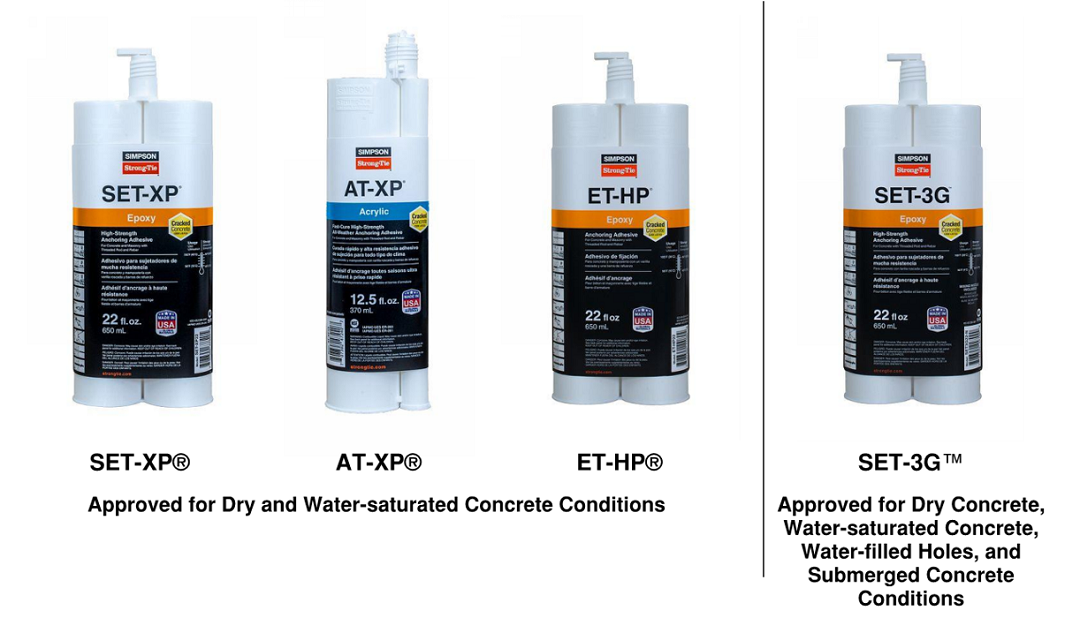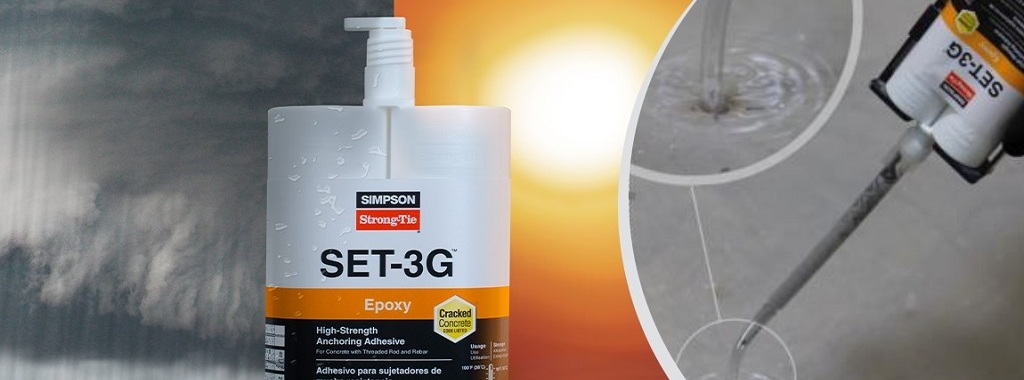Modern construction schedules and conditions create a demand for solutions that can perform in a wide variety of environments. In the following post, Field Engineer Chris Johnson provides a rundown of different concrete and hole conditions for adhesive anchoring, the related design factors, and proper installation instructions and approved adhesive products for submerged anchorage.
When it comes to anchoring threaded rod or rebar into concrete using adhesive anchorage, did you know the moisture content of the base material plays a crucial role in determining not only the bond strength of the adhesive, but also what adhesive product is appropriate for that concrete and hole condition? Let’s first review the different concrete and hole condition types there are as defined by ICC-ES AC308 Acceptance Criteria for Post-Installed Adhesive Anchors in Concrete Elements:
- Dry Concrete — Cured concrete whose moisture content is in equilibrium with surrounding non-precipitate atmospheric conditions.
-
- Example: An adhesive anchor is being installed into a dry foundation slab, which has not been exposed recently to rain or water. This condition is fairly typical, especially when anchoring in dry, interior environments.
- Water-Saturated Concrete — Concrete that, at the time of anchor installation, has been exposed to water over a sufficient length of time to have the maximum possible amount of water absorbed into the concrete pore structure to a depth equal to the anchor embedment depth.
-
- Example: A set of predrilled holes have been filled with water for a few days after a rainstorm passed by a construction site. The construction crew has removed the standing water from the holes by blowing air in the holes. However, the concrete and hole surface are still saturated with the water absorbed.
- Water-Filled Concrete Hole — A drilled hole in water-saturated concrete that is clean yet contains standing water at the time of installation.
-
- Example: As in the water-saturated concrete example, rain has filled a set of predrilled holes set for adhesive anchoring. However, for a water-filled concrete application, the construction crew does not remove the standing water and the standing water remains in place at the time of adhesive anchor installation.
- Submerged Concrete — Water-saturated concrete that is fully submerged at the time of hole drilling and anchor installation.
-
- Example: Construction in a marine environment requires an adhesive anchorage installation below the water line, which means drilling the anchor hole and installing the adhesive in underwater concrete.
Each of the four different concrete and hole conditions listed above (dry, water-saturated, water-filled hole, and submerged) creates a unique construction condition. These concrete and hole types also play a factor in the performance data for adhesive anchors. A product’s sensitivity to this installation condition is considered when determining the product’s “Anchor Category,” which then results in an appropriate strength reduction factor. These strength reduction factors apply when the load combination from the IBC or ACI 318 are used and the requirements of ACI 318-19 17.5.3, ACI 318-14 17.3.3 or ACI 318-11 D.4.3, as applicable, are met. The appropriate strength reduction factors are published within the adhesive product’s Evaluation Report. Additionally, the strength reduction factor is automatically considered and utilized within calculations when performing anchorage design within the Simpson Strong-Tie Anchor Designer software.
Simpson Strong-Tie® SET-3G™ Anchoring Adhesive
SET-3G high–strength epoxy adhesive is approved for dry concrete, water-saturated concrete, water-filled holes, and submerged concrete conditions.
It’s worth noting that not all adhesive anchor products are approved for all concrete and hole conditions. The ICC-ES AC308 contains testing criteria for adhesive anchors which include reliability tests for dry concrete, water-saturated concrete, water-filled holes, and submerged concrete. However, only dry and water-saturated concrete are required base material conditions. Water-filled holes and submerged concrete are optional tests when evaluating adhesive anchors for cracked and uncracked concrete conditions. This means that, unless an adhesive anchor product specifically goes through the water-filled hole and/or submerged concrete testing, it is not approved for use in these installation conditions.
Simpson Strong-Tie offers a wide variety of code-listed adhesive anchorage solutions (see Figure 1). SET-XP, AT-XP, and ET-HP are approved for installation in dry or water-saturated concrete.
SET-3G runs the full gamut of concrete and hole conditions — dry concrete, water-saturated concrete, water-filled holes, and submerged concrete.

Weather and construction site conditions can vary by the day or even by the hour. Knowing the right anchoring solution can be the key to making sure a project stays on schedule. SET-3G provides a versatile anchoring solution for the best and worst conditions. For further information on features and benefits of SET-3G, including installation instructions, utilize the SET-3G high-strength epoxy adhesive submerged concrete hole installation flier.
Visit strongtie.com to review the full line of anchoring solutions that Simpson Strong-Tie has to offer. For fast and easy anchor designs, be sure to download Simpson Strong-Tie Anchor Designer, which allows structural engineers the ability to design both post-installed and cast-in-place anchor solutions that satisfy the latest strength design provisions.




